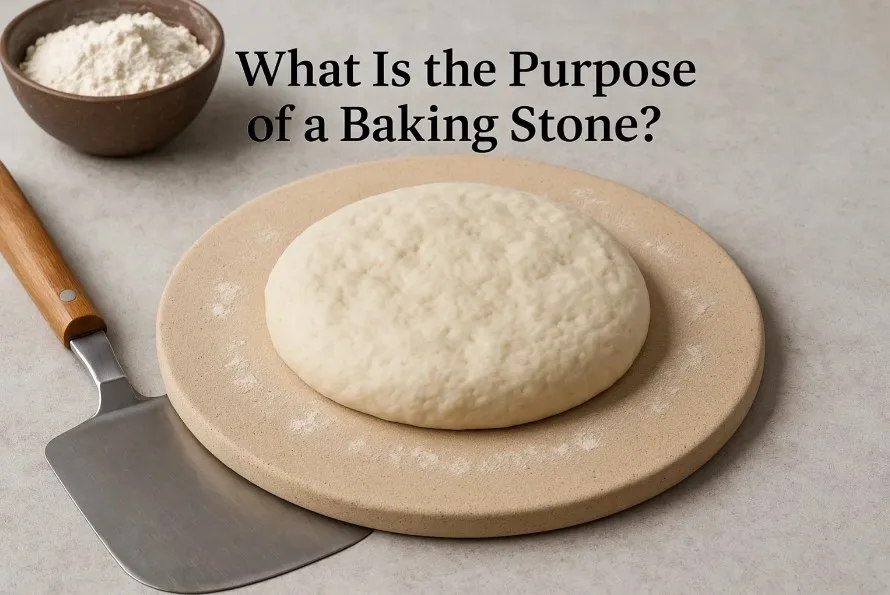A baking stone mimics a professional oven floor, absorbing and evenly distributing heat for crispier pizza crusts, artisanal breads, and perfectly golden pastries!
Raise your hand if you’ve ever burnt the bottom of a pizza while trying to get the top to bubble and blister. That was me a few years back, standing in my kitchen, hopelessly rotating a half-cooked, half-charred dough. Enter the baking stone: a simple slab that flipped my baking game on its head. But here’s the twist—it’s not just about pizza. Let me walk you through why every oven deserves its own culinary sidekick.

Secret Weapon: How a Baking Stone Changes the Game
When I first started experimenting with bread baking at home, I thought a baking stone was just for pizza. I couldn’t have been more wrong. The truth is, a baking stone is a secret weapon for anyone chasing that elusive crispy crust and even baking—whether you’re making pizza, sourdough, flatbreads, or even biscuits. Let me walk you through how a simple slab of stone can completely change your baking game.
Mimicking the Magic of Brick Ovens

One of the biggest baking stone benefits is how it mimics the effect of a brick oven. If you’ve ever had pizza from a wood-fired oven, you know the crust is something special—crispy on the outside, chewy inside, and never soggy.
At home, a baking stone absorbs and radiates heat in a way that standard metal trays just can’t. This means you get that same intense, even heat distribution, which is key for even baking and a golden, crispy crust.
Goodbye, Soggy Centers
Here’s where the science comes in. Research shows that baking stones absorb excess moisture from the dough as it bakes. This is crucial for preventing those dreaded soggy centers—no more doughy disasters in the middle of your pizza or bread.
The stone pulls moisture away, allowing the bottom to crisp up beautifully. I remember the first time I used my baking stone for sourdough: the bottom was suddenly golden and crisp, not pale and soft like before. It was a total game-changer.
Even Baking for More Than Just Pizza
It’s not just pizza that benefits. Baking stones are ideal for flatbreads, baguettes, and even buttermilk biscuits. The stone’s ability to deliver even baking eliminates hot spots in your oven, so everything cooks uniformly. No more rotating trays or worrying about burnt edges and undercooked centers.
The result? A consistent, professional-quality bake every time.
The Secret to Oven Spring
Another often-overlooked benefit is how a baking stone enhances oven spring—that initial burst of rise you get when dough hits a hot surface. For artisan breads, this means a better rise, open crumb, and that signature rustic look. Studies indicate that the rapid heat transfer from the stone helps the dough expand quickly, locking in moisture and flavor while creating a gorgeous crust.
Personal Experience: Sourdough Revelation
My first try with a baking stone was with a loaf of sourdough. I’d struggled with pale, soft bottoms for months. The difference was immediate: a crispy, golden bottom and a rise I’d never seen before. It was like unlocking a new level in my bread baking journey.
A baking stone is a magic carpet ride straight to crispy town. – Marc Vetri
Quick Comparison Table: Baking Stone Benefits
| Baking Stone Benefit | How It Helps | Best For |
|---|---|---|
| Even Baking | Eliminates hot spots in ovens | Pizza, flatbread, sourdough bread |
| Moisture Absorption | Prevents soggy results by absorbing excess dough moisture | Pizza, bread, biscuits |
All in all, the humble baking stone is much more than a pizza accessory. It’s the unsung hero behind every crispy crust and evenly baked loaf that comes out of my oven.
From Pizza to Sourdough: Real Versatility with Surprising Results
When I first picked up a pizza stone, I’ll admit, I thought it was just for making pizza. But after a few months of experimenting, I realized the real magic of baking stones is their versatility.
The Baking Stone Uses list is much longer than most people expect. Sure, it turns a regular oven into a bakery-level pizza maker—hello, pro crusts at home—but it’s also a secret weapon for bread baking, juicy meats, and roasted veggies.
Let’s start with the obvious. A Pizza Stone is famous for making pizzas with that signature crispy, chewy crust. The high heat retention and even distribution mimic the effects of a brick oven, which is something most home ovens can’t do on their own. But here’s where things get interesting: Pizza Stone Uses go way beyond pizza. I’ve roasted vegetables on mine, and the results are always the same—caramelized outsides, tender insides, and a flavor that’s hard to beat. Even meats benefit; they cook evenly and stay juicy, thanks to the stone’s ability to hold and radiate heat.

One night, on a whim, I tried baking buttermilk biscuits. I was honestly shocked. They puffed up and browned like never before. The stone’s heat capacity shortened the baking time and gave them a golden, crisp bottom without drying them out. Research shows that baking stones absorb moisture from dough, which helps prevent soggy centers and promotes that bakery-quality crust, whether you’re making biscuits, sourdough bread, or flatbread.
Speaking of Bread Baking, I’ve found that sourdough loaves and baguettes come out with a professional finish when baked on a stone. The quick, even heat gives a great oven spring, resulting in a better rise and shape. As Peter Reinhart famously said:
Once you’ve made real sourdough on a baking stone, there’s no going back.
That quote really rings true. After baking sourdough on a stone, I can’t imagine going back to a regular baking sheet. The crust is crisp, the crumb is airy, and the flavor is just better. And it’s not just for classic breads—flatbreads, naan, pita, and even “baguette-wannabes” all benefit from the stone’s consistent heat.
What surprised me most is how much a baking stone can improve foods you might not expect. Roasted veggies, juicy meats, and even quick breads all come out better. Studies indicate that the high heat capacity of baking stones shortens cooking time and ensures food cooks more evenly. That means less time in the oven, and more time enjoying the results.
Here’s a quick look at some of the most surprising Baking Stone Uses:
| Food | Benefit |
|---|---|
| Pizza | Bakery-quality, crispy crust |
| Sourdough Bread | Better rise, golden crust |
| Buttermilk Biscuits | Puffed, browned, never soggy |
| Flatbreads & Baguettes | Even bake, artisan finish |
| Roasted Veggies | Caramelized, tender, flavorful |
| Juicy Meats | Even cooking, juicy inside |
In short, Pizza Stone Uses extend far beyond pizza. From sourdough bread to roasted veggies and juicy meats, a baking stone is a surprisingly versatile tool that brings professional results to your home kitchen.
Choosing, Caring, and Wild Mistakes: My Journey into Baking Stones
When I first started baking at home, I thought a Baking Stone was just for pizza. It turns out, there’s a whole world of Baking Stone Benefits waiting to be discovered—if you know what to look for and how to care for these simple, sturdy tools. Let me walk you through what I’ve learned, including a few mistakes I’d rather forget (but you’ll benefit from hearing about).
First, let’s talk about material. The two most common types of baking stones you’ll find are cordierite and ceramic. Cordierite stones are the workhorses of the baking world. They handle thermal shock—that sudden change from cold to hot—much better than ceramic. If you’ve ever heard a stone crack in the oven, chances are it was ceramic and not cordierite.

Ceramic stones are usually less expensive, but they’re more fragile. Over time, both types darken with use, which actually improves their nonstick properties. That’s one of the hidden perks: the more you use your stone, the better it gets.
Now, about those mistakes. I’ve cracked a couple of stones in my time, and every time it’s been because I rushed the process. Here’s the golden rule: always preheat your baking stone slowly. Put it in a cold oven, then turn on the heat.
Let the stone warm up gradually with the oven. Never, ever rinse a hot stone with cold water. The rapid temperature change can cause it to fracture. Trust me, the sound is heartbreaking, and the cleanup isn’t much fun either.
One of the things I love most about baking stones is how low-maintenance they are. Unlike other kitchen gadgets that need constant cleaning or special care, a baking stone just needs a quick brush-off after use. Don’t use soap; just scrape off any stuck bits and let the stone age naturally.
In fact, research shows that baking stones improve with age and use. The surface darkens, the nonstick properties increase, and the flavor of your bread or pizza seems to get better over time. It’s the opposite of most kitchen tools, which wear out or lose their luster.
And here’s a fun thought experiment: could a baking stone double as a heat source for a makeshift winter bread blanket? I haven’t tried it (yet), but the idea isn’t as wild as it sounds. The stone’s ability to retain and distribute heat evenly is what makes it so valuable in baking. It’s what gives you that crispy crust and perfect oven spring, whether you’re making pizza, sourdough, or even roasting vegetables.
The best baking tool is the one you forget about—until you taste the bread. – Jeffrey Hamelman
In the end, the Baking Stone is a practical, fuss-free addition to any home kitchen. Its benefits go far beyond pizza, and with just a little care, it will reward you with years of delicious results. If you’re looking for a tool that quietly improves everything you bake, this is it.
Frequently Asked Questions (FAQs)
Can I use a baking stone in a gas oven?
Yes! Baking stones work in gas, electric, and convection ovens.
Do I need to season a baking stone?
Only if it’s cast iron. Ceramic and cordierite stones don’t need seasoning.
Why does my baking stone crack?
Sudden temperature changes are the main cause. Always preheat it slowly.
Can I bake cookies on a baking stone?
Absolutely! It helps cookies bake evenly with crisp edges.
How thick should a baking stone be?
Aim for at least ½ inch thick for better heat retention.
Conclusion
So, what is the purpose of a baking stone? It’s all about achieving professional-quality baked goods at home. Whether you’re making pizza, bread, or cookies, a baking stone ensures even heat, crispy crusts, and consistent results.
If you’re serious about baking, investing in a good baking stone is worth it. Start with a basic cordierite or ceramic stone, follow the care tips, and enjoy restaurant-worthy results every time.
“Baking is a science, but with the right tools, it becomes an art.” – Julia Child

